A page from the "Causes of Color" exhibit...
Interesting books to learn more

We are often asked about books we might recommend. This exhibit is based on hundreds of different sources, both online and in print. Below are several we like:
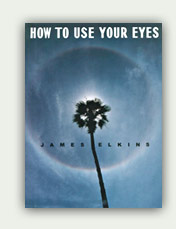 |
How to Use Your Eyes by James Elkins Invites us to look at – and maybe to see for first time – the world around us, with breathtaking results. Note, only a little of this book is about colors. Other chapters include things that everyone sees, but no one notices: cracks in pavement, culverts under highways, grass, sand. We appreciated sunsets much more after reading this book. (Published October 2000, Routledge; ISBN: 0415922542. 272 pages.) |
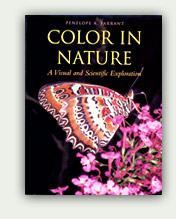 |
Color in Nature: A Visual and Scientific Exploration by Penelope A. Farrant A beautiful and interesting book with 300 color photos and illustrations. The book focuses on a dozen different topics, such as "the universe" and "animal pigments." Answers why snow is white, a leaf green, ocean water blue, and a zebra striped? Not too technical. (Published 1999, Blandford Pr, ISBN: 071372806X. 208 pages) |
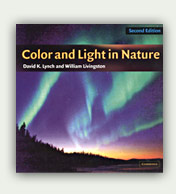 |
Color and Light in Nature by David K. Lynch and William Livingstone Explains most phenomenon of the sun, atmosphere, clouds, and land. Why is the sky blue? Why do mountains glow in the dark? Is the darkest always before the dawn? Take the question of why stars twinkle, for instance: twinkling, astronomers Lynch and Livingston observe, is strongest with stars that are low in the sky, and then on a clear and windy night, when starlight passing through the atmosphere encounters little pockets of turbulence that bend its rays "momentarily away from our eyes." (2nd edition. Published July 2001, Cambridge Univ Press; ISBN: 0521775043. 288 pages.) |
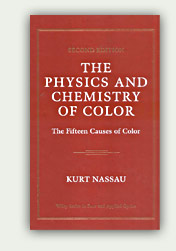 |
The Physics and Chemistry of Color: The Fifteen Causes of Color by Kurt Nassau A primary reference for this web site. The book is unique in that it addresses all causes of colors. Sometimes his explainations are awkward. He also has versions of this book written as chapters and articles elsewhere. (Published 1983, John Wiley & Sons, ISBN: 0471867764. 480 pages.) |
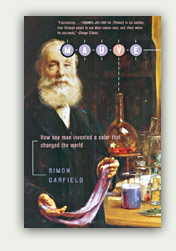 |
Mauve: How One Man Invented a Color That Changed the World by Simon Garfield In 1856, while trying to synthesize artificial quinine, 18-year-old chemistry student William Perkin instead produced a murky residue. Fifty years later, he described the event: he "was about to throw a certain residue away when I thought it might be interesting. The solution of it resulted in a strangely beautiful color." Perkin had stumbled across the world’s first aniline dye, a color that became known as mauve. (Published 2002, W. W. Norton & Company, ISBN: 0393323137. 242 pages) |



